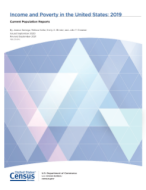Income and Poverty in the United States: 2019
Income and Poverty in the United States: 2019
Report Number: P60-270
Note: Revisions were made to estimates in Table A4 (page 38) for the 30th and 70th percentiles. Other minor differences are due to updates in the programming of this table.
Introduction
This report presents data on income, earnings, income inequality, and poverty in the United States based on information collected in the 2020 and earlier Current Population Survey Annual Social and Economic Supplements (CPS ASEC) conducted by the U.S. Census Bureau.
Highlights
Income:
- Median household income was $68,703 in 2019, an increase of 6.8 percent from the 2018 median of $64,324 (Figure 1 and Table A-1).
- The 2019 real median incomes of family households and nonfamily households increased 7.3 percent and 6.2 percent from their respective 2018 estimates (Figure 1 and Table A-1). This is the fifth consecutive annual increase in median household income for family households, and the second consecutive increase for nonfamily households.
- The 2019 real median incomes of White, Black, Asian, and Hispanic households all increased from their 2018 medians (Figure 1 and Table A-1).
- Real median household incomes increased for all regions in 2019; 6.8 percent in the Northeast, 4.8 percent in the Midwest, 6.1 percent in the South, and 7.0 percent in the West (Figure 1 and Table A-1).
Earnings:
- Between 2018 and 2019, the real median earnings of all workers and full-time, year-round workers increased 1.4 percent and 0.8 percent, respectively (Figure 4 and Table A-6).
- The 2019 real median earnings of men ($57,456) and women ($47,299) who worked full-time, year-round increased by 2.1 percent and 3.0 percent, respectively (Figure 4 and Table A-6). The 2019 female-to-male earnings ratio was 0.823, not statistically different from the 2018 ratio (Figure 5).
- Between 2018 and 2019, the total number of people with earnings, regardless of work experience, increased by about 2.2 million. The number of full-time, year-round workers increased by approximately 1.2 million.
Poverty:
- The official poverty rate in 2019 was 10.5 percent, down 1.3 percentage points from 11.8 percent in 2018. This is the fifth consecutive annual decline in poverty. Since 2014, the poverty rate has fallen 4.3 percentage points, from 14.8 percent to 10.5 percent (Figure 7 and Table B-5).
- The 2019 poverty rate of 10.5 percent is the lowest rate observed since estimates were initially published in 1959 (Figure 7 and Table B-5).
- In 2019, there were 34.0 million people in poverty, approximately 4.2 million fewer people than 2018 (Figure 7 and Table B-1).
- For all demographic groups shown in Figure 8 and Table B-1, poverty rates in 2019 were either lower than or not statistically different from those in 2018.
- Between 2018 and 2019, poverty rates declined for all race and Hispanic origin groups shown in Figure 8 and Table B-1. The poverty rate for Whites decreased 1.0 percentage point to 9.1 percent. The poverty rate for Blacks decreased by 2.0 percentage points to 18.8 percent. The poverty rate for Hispanics decreased by 1.8 percentage points to 15.7 percent. The poverty rate for Asians decreased 2.8 percentage points to 7.3 percent (Figure 8 and Tables B-1 and B-5).
- Between 2018 and 2019, poverty rates for people under the age of 18 decreased 1.8 percentage points, from 16.2 percent to 14.4 percent. Poverty rates decreased 1.2 percentage points for people aged 18 to 64, from 10.7 percent to 9.4 percent. The poverty rate for people aged 65 and older decreased by 0.9 percentage points, from 9.7 percent to 8.9 percent (Figure 8 and Table B-1).
Tables
Income:
Income Inequality:
Earnings:
Poverty:
Figures
Income:
Income Inequality:
Earnings:
Poverty:
Source Information
Others in Series
Publication
Custodial Mothers and Fathers and Their Child Support: 2017
This report uses the 1994-2018 Current Population Survey Child Support Supplements to examine characteristics of custodial parents and their children.
Publication
Income of Families and Persons in the United States: 1956
Distribution of families and unrelated individuals by total money income, by color, type of family, age, size of family, number of earners, and type of income.
Publication
Health Insurance Coverage in the United States: 2019
This report presents data on health insurance coverage in the United States based on information collected in the 2020 CPS ASEC.
Page Last Revised - June 9, 2022






